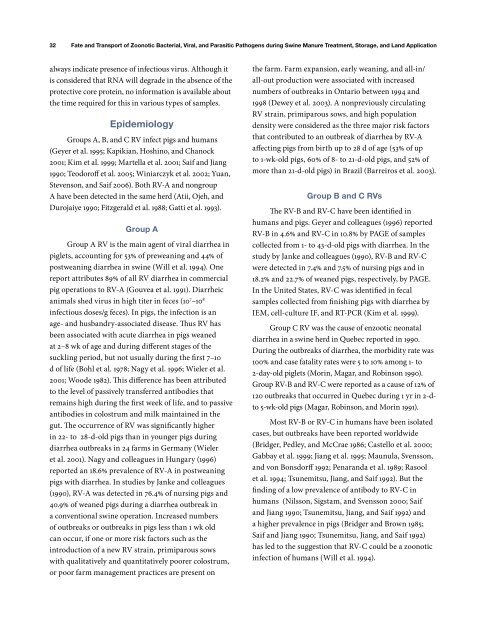Fate and Transport of Zoonotic Bacterial, Viral, and - The Pork Store ...
Fate and Transport of Zoonotic Bacterial, Viral, and - The Pork Store ...
Fate and Transport of Zoonotic Bacterial, Viral, and - The Pork Store ...
You also want an ePaper? Increase the reach of your titles
YUMPU automatically turns print PDFs into web optimized ePapers that Google loves.
32<br />
<strong>Fate</strong> <strong>and</strong> <strong>Transport</strong> <strong>of</strong> <strong>Zoonotic</strong> <strong>Bacterial</strong>, <strong>Viral</strong>, <strong>and</strong> Parasitic Pathogens during Swine Manure Treatment, Storage, <strong>and</strong> L<strong>and</strong> Application<br />
always indicate presence <strong>of</strong> infectious virus. Although it<br />
is considered that RNA will degrade in the absence <strong>of</strong> the<br />
protective core protein, no information is available about<br />
the time required for this in various types <strong>of</strong> samples.<br />
Epidemiology<br />
Groups A, B, <strong>and</strong> C RV infect pigs <strong>and</strong> humans<br />
(Geyer et al. 1995; Kapikian, Hoshino, <strong>and</strong> Chanock<br />
2001; Kim et al. 1999; Martella et al. 2001; Saif <strong>and</strong> Jiang<br />
1990; Teodor<strong>of</strong>f et al. 2005; Winiarczyk et al. 2002; Yuan,<br />
Stevenson, <strong>and</strong> Saif 2006). Both RV-A <strong>and</strong> nongroup<br />
A have been detected in the same herd (Atii, Ojeh, <strong>and</strong><br />
Durojaiye 1990; Fitzgerald et al. 1988; Gatti et al. 1993).<br />
group A<br />
Group A RV is the main agent <strong>of</strong> viral diarrhea in<br />
piglets, accounting for 53% <strong>of</strong> preweaning <strong>and</strong> 44% <strong>of</strong><br />
postweaning diarrhea in swine (Will et al. 1994). One<br />
report attributes 89% <strong>of</strong> all RV diarrhea in commercial<br />
pig operations to RV-A (Gouvea et al. 1991). Diarrheic<br />
animals shed virus in high titer in feces (10 7 –10 8<br />
infectious doses/g feces). In pigs, the infection is an<br />
age- <strong>and</strong> husb<strong>and</strong>ry-associated disease. Thus RV has<br />
been associated with acute diarrhea in pigs weaned<br />
at 2–8 wk <strong>of</strong> age <strong>and</strong> during different stages <strong>of</strong> the<br />
suckling period, but not usually during the first 7–10<br />
d <strong>of</strong> life (Bohl et al. 1978; Nagy et al. 1996; Wieler et al.<br />
2001; Woode 1982). This difference has been attributed<br />
to the level <strong>of</strong> passively transferred antibodies that<br />
remains high during the first week <strong>of</strong> life, <strong>and</strong> to passive<br />
antibodies in colostrum <strong>and</strong> milk maintained in the<br />
gut. <strong>The</strong> occurrence <strong>of</strong> RV was significantly higher<br />
in 22- to 28-d-old pigs than in younger pigs during<br />
diarrhea outbreaks in 24 farms in Germany (Wieler<br />
et al. 2001). Nagy <strong>and</strong> colleagues in Hungary (1996)<br />
reported an 18.6% prevalence <strong>of</strong> RV-A in postweaning<br />
pigs with diarrhea. In studies by Janke <strong>and</strong> colleagues<br />
(1990), RV-A was detected in 76.4% <strong>of</strong> nursing pigs <strong>and</strong><br />
40.9% <strong>of</strong> weaned pigs during a diarrhea outbreak in<br />
a conventional swine operation. Increased numbers<br />
<strong>of</strong> outbreaks or outbreaks in pigs less than 1 wk old<br />
can occur, if one or more risk factors such as the<br />
introduction <strong>of</strong> a new RV strain, primiparous sows<br />
with qualitatively <strong>and</strong> quantitatively poorer colostrum,<br />
or poor farm management practices are present on<br />
the farm. Farm expansion, early weaning, <strong>and</strong> all-in/<br />
all-out production were associated with increased<br />
numbers <strong>of</strong> outbreaks in Ontario between 1994 <strong>and</strong><br />
1998 (Dewey et al. 2003). A nonpreviously circulating<br />
RV strain, primiparous sows, <strong>and</strong> high population<br />
density were considered as the three major risk factors<br />
that contributed to an outbreak <strong>of</strong> diarrhea by RV-A<br />
affecting pigs from birth up to 28 d <strong>of</strong> age (53% <strong>of</strong> up<br />
to 1-wk-old pigs, 60% <strong>of</strong> 8- to 21-d-old pigs, <strong>and</strong> 52% <strong>of</strong><br />
more than 21-d-old pigs) in Brazil (Barreiros et al. 2003).<br />
group B <strong>and</strong> C rVs<br />
<strong>The</strong> RV-B <strong>and</strong> RV-C have been identified in<br />
humans <strong>and</strong> pigs. Geyer <strong>and</strong> colleagues (1996) reported<br />
RV-B in 4.6% <strong>and</strong> RV-C in 10.8% by PAGE <strong>of</strong> samples<br />
collected from 1- to 43-d-old pigs with diarrhea. In the<br />
study by Janke <strong>and</strong> colleagues (1990), RV-B <strong>and</strong> RV-C<br />
were detected in 7.4% <strong>and</strong> 7.5% <strong>of</strong> nursing pigs <strong>and</strong> in<br />
18.2% <strong>and</strong> 22.7% <strong>of</strong> weaned pigs, respectively, by PAGE.<br />
In the United States, RV-C was identified in fecal<br />
samples collected from finishing pigs with diarrhea by<br />
IEM, cell-culture IF, <strong>and</strong> RT-PCR (Kim et al. 1999).<br />
Group C RV was the cause <strong>of</strong> enzootic neonatal<br />
diarrhea in a swine herd in Quebec reported in 1990.<br />
During the outbreaks <strong>of</strong> diarrhea, the morbidity rate was<br />
100% <strong>and</strong> case fatality rates were 5 to 10% among 1- to<br />
2-day-old piglets (Morin, Magar, <strong>and</strong> Robinson 1990).<br />
Group RV-B <strong>and</strong> RV-C were reported as a cause <strong>of</strong> 12% <strong>of</strong><br />
120 outbreaks that occurred in Quebec during 1 yr in 2-d-<br />
to 5-wk-old pigs (Magar, Robinson, <strong>and</strong> Morin 1991).<br />
Most RV-B or RV-C in humans have been isolated<br />
cases, but outbreaks have been reported worldwide<br />
(Bridger, Pedley, <strong>and</strong> McCrae 1986; Castello et al. 2000;<br />
Gabbay et al. 1999; Jiang et al. 1995; Maunula, Svensson,<br />
<strong>and</strong> von Bonsdorff 1992; Penar<strong>and</strong>a et al. 1989; Rasool<br />
et al. 1994; Tsunemitsu, Jiang, <strong>and</strong> Saif 1992). But the<br />
finding <strong>of</strong> a low prevalence <strong>of</strong> antibody to RV-C in<br />
humans (Nilsson, Sigstam, <strong>and</strong> Svensson 2000; Saif<br />
<strong>and</strong> Jiang 1990; Tsunemitsu, Jiang, <strong>and</strong> Saif 1992) <strong>and</strong><br />
a higher prevalence in pigs (Bridger <strong>and</strong> Brown 1985;<br />
Saif <strong>and</strong> Jiang 1990; Tsunemitsu, Jiang, <strong>and</strong> Saif 1992)<br />
has led to the suggestion that RV-C could be a zoonotic<br />
infection <strong>of</strong> humans (Will et al. 1994).


